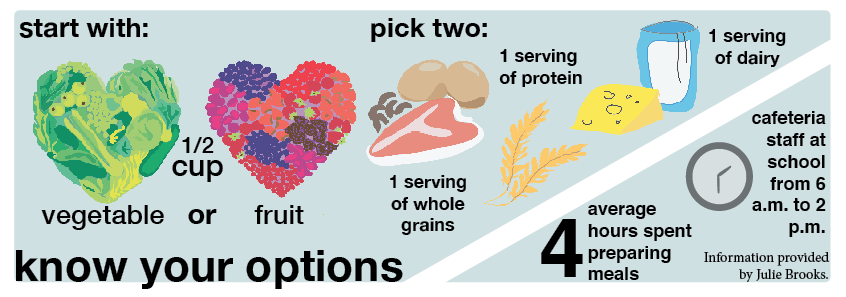The Food Fight
Cafeteria standards deemed mediocre; students voice need for change
We’ve all seen it — the brown lettuce, the sometimes crunchy, sometimes soggy meat, the seemingly unwashed vegetables and the food that sits for hours “on ice.” The pizza is only semi-edible with its hard-as-nails crust and its less-than-delicious grease.
The salad bar is used by students who like to eat healthier, but sophomore Brenna Stroud said it’s not quite up to par.
“The [greens] at the salad bar aren’t very fresh and usually have some brown leaves,” she said.
Cafeteria manager Julie Brooks said in order to change the food, Blue Valley would probably have to take the issue up with more than just the administrators, and it would have to be a district-wide decision.
“I would prefer less processed food,” Brooks said. “I don’t think that’s going to happen — we’d have to talk to processing.”
According to “The New York Post,” European school lunches include rice, beans, soups, grilled or browned pieces of meat and several fresh, multi-colored fruits and vegetables.
The American school lunch usually includes a slice or two of pizza, a cheeseburger or a breaded chicken sandwich.
“The food is just junk food trying to be healthy food,” sophomore Mallory Norris said.
Norris said the lunch employees are really nice and try their best to do their job.
“The lunch ladies work really hard and are always nice when I check out my food,” she said. “They try their hardest to make the lunchroom food healthy.”
The options in the lunchroom are the same as they were a few years ago, Brooks said.
“They’ve taken out a lot of the salt and sugars, and they’ve made everything whole grain,” she said. “But basically they’ve used the same foods and re-did them.”
If students do want something healthy, like a Naked juice or a salad, they have to pay more, sophomore Brooke Rowland said.
“The price of the Naked drinks are overdone because I can get one twice the size for less at QuikTrip,” she said.
Norris said the lunchroom does have healthier food, but it still needs some work.
“I would like the lunch room to have a greater variety of choices and more fresh foods than processed frozen foods,” Norris said.
Brooks said in order to get away from processed foods, the lunch employees would have to find people who can cook a meal and also find all the ingredients without any preservatives or salts.
“To start from scratch is the only way to have fresher food,” Brooks said. “Even with the Obama food plan, it’s taken almost three years to get whole grain in the lunchroom. There are only a few of us who can cook, and the rest know how to reheat. You’d have to find more employees who can cook from scratch, and that’s also a really long process.”

Charlotte Rooney is a senior and the opinion editor for “The Tiger Print.” She loves writing opinions about current events and writing news stories...

Courtney Carpenter is the co-editor of “The Tiger Print.” She enjoys writing feature stories and meeting new people. Courtney loves playing volleyball,...




